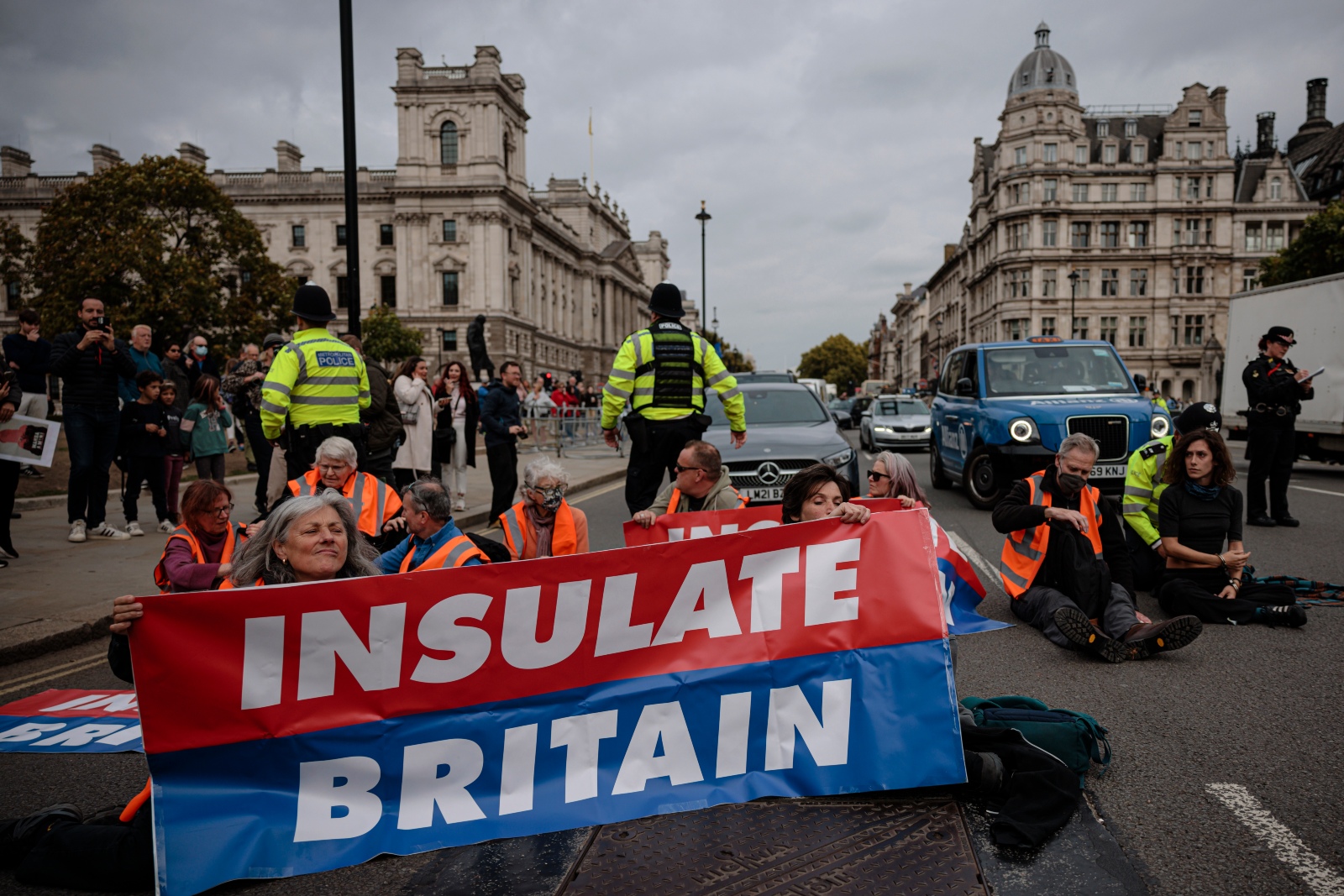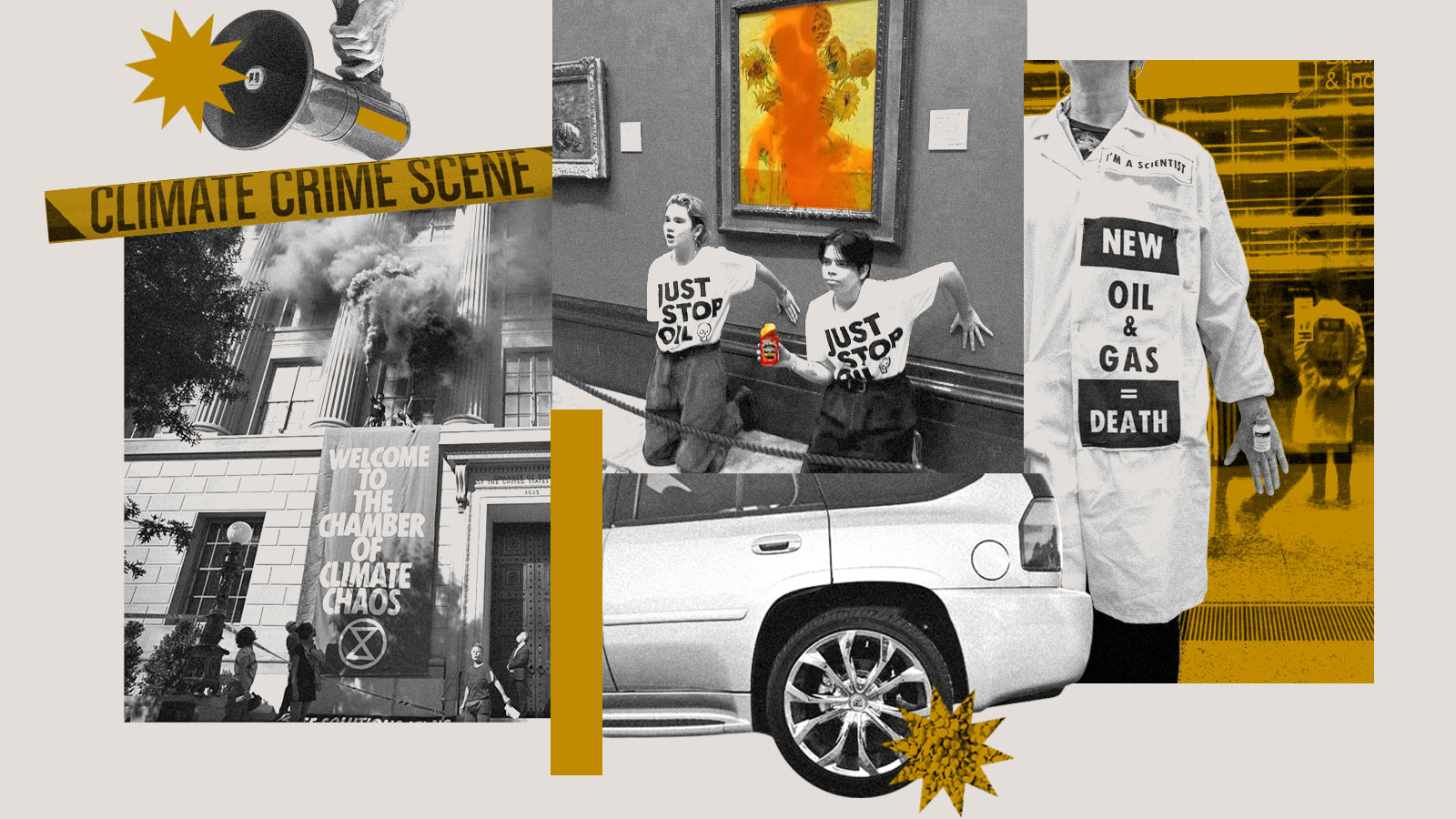2022 may be remembered as the year that climate protests got weird. Activists prowled cities in the dead of night, using lentils to deflate the tires of thousands of SUVs. They glued themselves to airport runways. They also glued themselves to priceless artwork in museums, dumped flour on a sports car painted by Andy Warhol, and, infamously, launched a can of Heinz tomato soup at the glass protecting Vincent van Gogh’s “Sunflowers.”
Frustrated with the sluggish pace of climate action, protesters turned to disruptive tactics, risking arrest and widespread disapproval. Activists made people late for work; they delayed flights; they were accused of vandalism. Their actions weren’t popular, but they anticipated that.
“We’re going to be noisy. We’re going to be disruptive. We’re going to be unignorable. We’re going to be a pain in the ass until you listen to us,” Emma Brown, a spokesperson for Just Stop Oil, the coalition behind the museum protests, recently told PBS Newshour. The group hopes to persuade the U.K. government to put a stop to all new fossil fuel projects.
When a pair of activists with Just Stop Oil tossed tomato soup at the van Gogh painting in London’s National Gallery in October, it sparked a widespread debate about the effectiveness of such tactics. In a survey of more than 2,000 Americans conducted within a month of the protest, 46 percent said that “disruptive non-violent actions including shutting down morning commuter traffic and damaging pieces of art” decreased their support for efforts to address climate change. Only 13 percent said such actions increased their support.

The thing is, the public rarely approves of disruptive protests — unless they happened sometime in the past. Suffragettes actually slashed paintings, permanently damaging them, and then were remembered as heroes. Even peaceful marches, as they unfold, are sometimes seen as unhelpful. After Martin Luther King Jr. delivered the iconic “I Have a Dream” speech following the 1963 March on Washington, three-quarters of Americans said they thought mass demonstrations harmed the cause, according to Gallup polling. The following year, President Lyndon B. Johnson signed the Civil Rights Act into law.
That doesn’t mean that throwing soup at famous paintings will bring down greenhouse gas emissions, but it does suggest that the public has a poor track record of guessing what makes social movements successful. Experts say that disruptive demonstrations play an important role in gathering attention for a cause and making tamer protests appear more acceptable by comparison.
“Confrontational protests, violent or not, are part of all successful social movements,” said Oscar Berglund, who researches climate activism and civil disobedience at the University of Bristol in the United Kingdom.
While climate protests are generally peaceful, fiery ones could raise the risk that things will get violent, depending on the circumstances. “The line between confrontational activism and violence is a very, very fuzzy line, particularly when you have law enforcement who may or may not be empowered to harm protesters,” said Dana Fisher, a sociologist at the University of Maryland who has studied the effectiveness of climate activism for two decades. States have recently passed draconian laws with harsh penalties for blocking fossil fuel infrastructure.
Despite that, there’s a growing appetite for nonviolent climate demonstrations. One-fifth of Americans under 40 say they’d likely participate in civil disobedience — such as sit-ins, blockades, or trespassing — to support action on climate change if a friend asked them to, according to a survey conducted last September by the Yale Program on Climate Change Communication. Fisher says that participation in civil disobedience appears to be on the rise, based on her surveys of AmeriCorps workers and climate organizers.
“There is potential here for a huge disruptive movement to arise quickly,” said Margaret Klein Salamon, the executive director of the Climate Emergency Fund, which backs nonviolent climate activism. Confrontational actions haven’t picked up speed in the United States as fast as they have in the United Kingdom, but there are signs that a wave may be starting here as well.
In April this year, climate scientists chained themselves to a JPMorgan Chase building in Los Angeles to protest the bank’s funding of fossil fuel projects. In the summer, drivers of SUVs and pickup trucks in New York, the Bay Area, and Chicago found their vehicles with tires deflated and a leaflet on their windshield: “Your gas guzzler kills.” It was the work of the Tyre Extinguishers, an international group aiming “to make it impossible” to own large personal vehicles in cities. Last month, protesters picketed at private airports in New Jersey, North Carolina, California, and Washington state to highlight the toll that private jets took on the planet.
Disruptive protests are, by their nature, uncomfortable. Salamon, who is also a clinical psychologist, says the public is living in a “state of mass delusion” with regard to the climate crisis, sleepwalking into catastrophe. The role of activists is to shake everyone awake.
“If you think about it from that perspective, it makes all the sense in the world why these activists would be unpopular. You know, they’re making people think about climate — they’re making people feel really painful feelings, because it’s such a tough reality,” Salamon said.

Confrontational tactics can draw criticism, anger, and even death threats. But many activists feel that more conventional means of protesting won’t bring results. A phenomenon called the “activist’s dilemma” illustrates the problem. Protesters often have to choose between moderate actions that are easily ignored or more extreme actions that might alienate the public.
“It isn’t fun: I hate disrupting people’s lives, and it’s upsetting that it’s come to this. But it has come to this,” an anonymous Tyre Extinguisher activist told Vice earlier this year. “We feel that nothing else will work — we don’t have any more time for letters or marches or waiting for more elections. We’ve had those strategies for 30 years and they’re not working. It’s time to shake things up.”
Phoebe Plummer, one of the soup throwers with Just Stop Oil, admitted that their action was, in their own words, “slightly ridiculous,” but argued that the absurdity of the protest was what got the conversation on climate action going. In the months preceding the “Sunflowers” incident, Just Stop Oil had attacked a more logical target: oil terminals. Activists blocked so much oil infrastructure in April that they forced one in three gas stations in southern England to close. But they received little international attention.
Disruptive protests play a role in setting the agenda by opening up space for issues that might otherwise not get discussed. Take Insulate Britain, a group that began blocking roads in the United Kingdom last September, demanding that the government retrofit all U.K. homes to make them more energy-efficient. The group was widely unpopular, with only 16 percent of people surveyed viewing them favorably one month later.

But in the month after the protests began, the number of times that print newspapers in the United Kingdom mentioned “insulation” had doubled (not including references to “Insulate,” part of the group’s name). By June this year, the issue had risen on the policy agenda, with former Prime Minister Boris Johnson drawing up plans to insulate thousands of homes before winter struck. At the time, one official suggested that the policy could be called — wait for it — “insulate Britain.”
It’s hard to draw a straight line from protest to policy change, but experts say disruptive demonstrations may be more helpful than many people believe. “The fact that it’s unpopular doesn’t mean that it’s ineffective,” Berglund said, referring to Insulate Britain. “Ultimately, even if people dislike what protesters do, it doesn’t automatically turn them against the course that those protesters are fighting for.”
Of course, such protests are not great for building broad movements. They’re probably not going to change the minds of the minority of Americans who oppose climate policies. “These activists and the groups that are organizing these kinds of activism are acutely aware that they’re not speaking to those people,” Fisher said. Instead, they’re trying to mobilize people who are already sympathetic. Polarizing the public has the effect of forcing people to take a stance on something they might not be thinking about otherwise.
And by some measures, the strategy might already be working. Fisher said that the soup incident was “through-the-roof effective” by many of the short-term goals activists use to judge effectiveness, such as media coverage, even if it’s unclear what effect the action will have in the long run. According to Just Stop Oil’s organizers, the attention-grabbing protest made it easier to recruit new people.
In the recent past, civil disobedience was seen by climate organizers as “a bad tool,” Fisher said. “But there’s no question that the young generation of climate activists absolutely include that as one of their tools now.”



